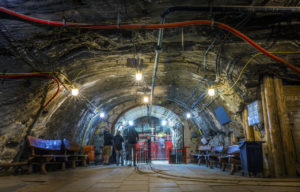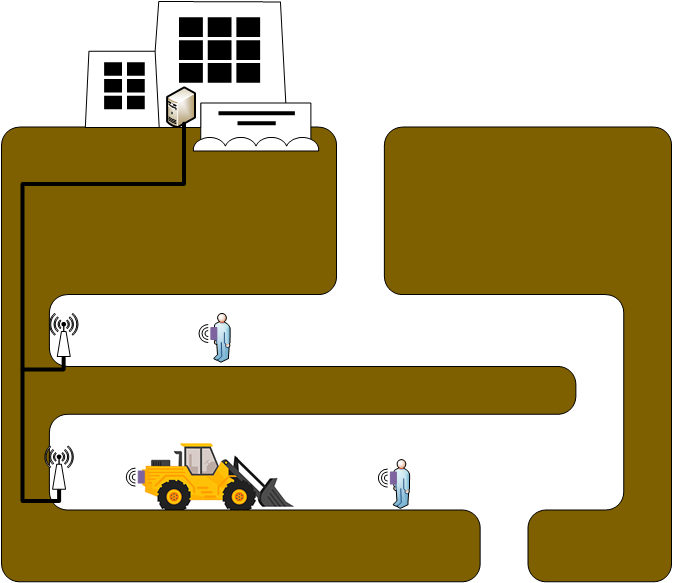
[From the last episode: We saw how we could take mechanical motion and turn it into an electrical signal.]
Today we take a break from the technical stuff and look at another industrial example of the IoTThe Internet of Things. A broad term covering many different applications where "things" are interconnected through the internet.. We’ve already looked at a couple of farming ones (SoilCares and Hands-Free Hectare). This time we go from the surface of the earth to deep within: a mine.
I talked with a company called Meglab; they have an IoT mining offering that helps addressWhen referring to memory, a binary number that shows where, within some memory block, the data you want is located. If you want to read or change that data, you have to give the address so that the right data is read or changed. several important aspects of a mining operation. I was directed to Meglab by a company called Sensera; they acquired a company called Nanotron (are you keeping up with this?), and Nanotron makes the wireless networkA collection of items like computers, printers, phones, and other electronic items that are connected together by switches and routers. A network allows the connected devices to talk to each other electronically. The internet is an example of an extremely large network. Your home network, if you have one, is an example of a small local network. that we’re going to feature in this story.
Let’s start with the key mining concerns that we’re going to address:
- Miner safety – this is a big one. It has several aspects:
- Knowing early when an accident or collision occurs
- Making sure the mine is safe after a blast
- Accounting for all miners after some kind of emergency
- Knowing where all the equipment is at any given time.
- Optimizing ventilation. Ventilation is key for breathability or for clearing harmful gasses, but it also can be expensive to run, so it’s better if you can be selective about when and where the ventilation is running all-out.
“Marco!…”
So here’s what they do. First, all miners and equipment get a tag. This tag sends a wireless “chirp” periodically. That chirp gets heard by other tags (who send it on) and, ultimately, by an access pointFor wireless network connections like WiFi, this is a router that takes your wireless signal and either connects it to other wireless signals or to a wired signal -- say, for going to the cloud.. If you’re not familiar with an access point, you’ve probably got one if you have WiFiA common type of wireless network used to connect computers and phones to each other and the internet. in your home. It’s the box that handles all the wireless trafficRefers to any kind of electronic message -- email, web request, streaming video, or anything else -- that travels over a network. and sends it out on your wired network or cable or phone line or something.
Here’s the first thing that this does: it lets everyone know where everyone is. How does it do that? By measuring how long it takes for a chirp from one tag to get to other tags or to the access point. This is called time of flight: the chirp is literally flying through the air at the speed of light (which is a known speed), and, by measuring how long it takes to get to the other end, you can tell how far it had to travel. If you measure the time of flight to every neighboring tag, you can pinpoint where the original tag is within about 10 meters.

Now, that original tag could be on a miner or it could be on a piece of equipment. Each tag has a unique ID number, so, if you know which tags are with which people or equipment, then you always know where everyone and everything is. This is important in the case of an emergency: if people are trapped, you know much more quickly who is trapped (and where) and who isn’t.
Crash Into Me
Some of the tags do more than just send chirps for location purposes. They also have sensorsA device that can measure something about its environment. Examples are movement, light, color, moisture, pressure, and many more.: accelerometers or thermometersA sensor that measures temperature. or even gas sensors.
So let’s say that two tractors run into each other. Under normal circumstances, if no one is hurt, they can radio for help. If people are hurt, then maybe not so much. In the worst case, someone has to realize that they haven’t heard from this or that guy for a while, and eventually they look around and find the crash scene.
But if the equipment tags have accelerometersA sensor that measures acceleration and deceleration., then they can tell when there’s been a rapid deceleration – just like the sensors that fire off the airbags in your car. The tags can then send an alert whether or not anyone was hurt.
Gassy Not-So-Goodness
An important mine operation is the blast, where a controlled explosion blows apart the rock material so that it can be scooped up and transported out. But this isn’t just some ordinary explosion on the surface, with lots of air and wind to clear the scene after it’s done. No, this is an explosion in a cave. Dust and potentially poisonous gasses (or, at the very least, too little oxygen) will fill the room until it manages to clear (with the help of ventilation).
So, traditionally, you have to spend about two hours after the blast checking out all the corners and recesses of the mine (not just where the blast happened) to make sure that there are no harmful gasses remaining. But, by putting tags with gas sensors on equipment and, perhaps, the walls, they can measure all of those areas immediately after the blast, and miners can re-enter much more quickly and safely.
Blowing in the Wind
Finally, a big one: so-called Ventilation on Demand, or VoD. Those gas and temperature sensors can give clues about what areas need more ventilation. Knowing where people are also helps: if there’s a corner of the mine where no one is, it doesn’t have to be as well ventilated, and you can save some money and energy by turning the fans down. If someone moves into the area, it will know, and it can spin the fans back up quickly to ensure a safe breathing environment.
IoT Details
So we’ve talked about the wireless chirp part of the network (a so-called swarm bee network – we may talk more about that in the future). But that gets us only to the access point. What then? How are all of those signals going to get from way underground up to the surface? Well, not wirelessly. But it can be any kind of wired network – most mines will already have that anyway. So that gets the signals up to the top.
But what gets them to the cloudA generic phrase referring to large numbers of computers located somewhere far away and accessed over the internet. For the IoT, computing may be local, done in the same system or building, or in the cloud, with data shipped up to the cloud and then the result shipped back down.? Ah, here’s where they differ from the classical IoT model. They don’t go to the cloud; there’s a serverA computer with a dedicated purpose. Older familiar examples are print servers (a computer that controls local printing) and file servers (a computer used for storing files centrally). More modern examples are web servers (the computers that handle your web requests when you use your browser) or application servers (computers dedicated to handling the computing needs of a specific application). Servers are often powerful, expensive machines since they have to handle a heavy load. up top that handles their needs locally. They don’t feel the need for the cloud, and they’re concerned that all it would do is to hurt securityRefers to whether or not IoT devices or data are protected from unauthorized viewers.. So, theoretically, there’s no “internet” in this IoT solution. But, aside from that detail, it works just like any other industrial IoT solution.
So, relating the Meglab mining solution to the four basic IoT elements, we have:
- Sensing: location, gas, temperature, and acceleration (maybe more).
- Communication: chirps moving through the swarm-bee wireless network and whatever network carries the messages to the surface.
- Computation: figuring out what the chirps and sensor results mean – locating people, deciding when a crash occurred, deciding when to turn on the fans, and deciding when it’s safe to enter an area.
- Actuation: turning the fans on or off. Possibly other things as well.

Leave a Reply